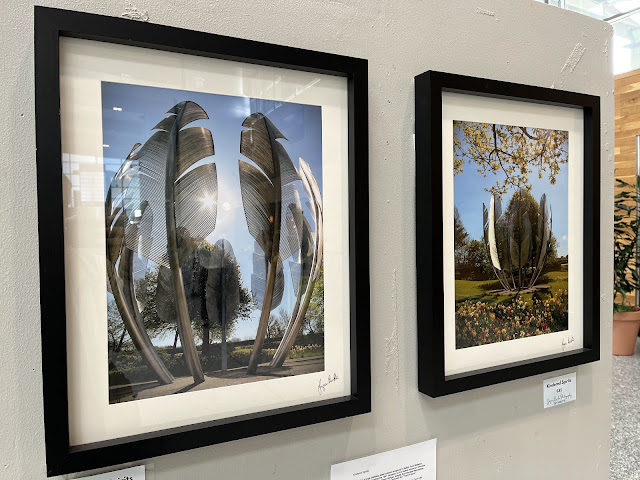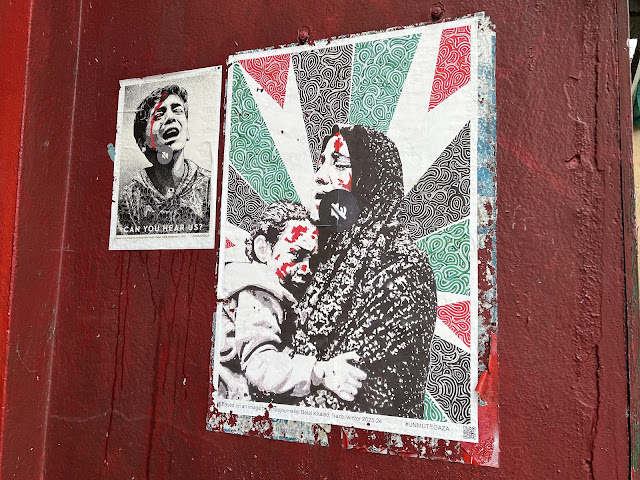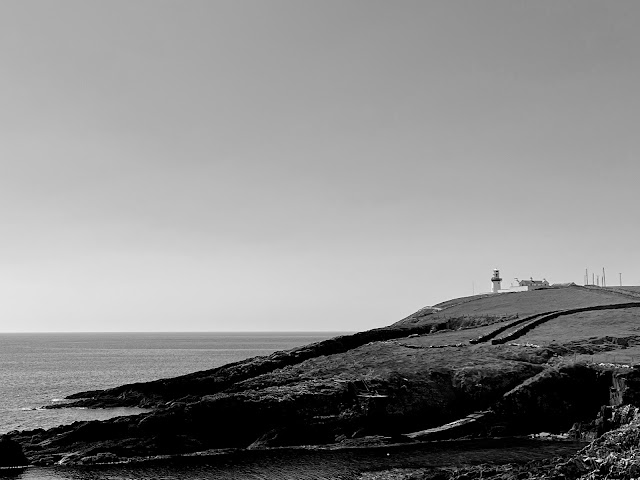December 31, 2024
Best of 2024 Film and Music
November 14, 2024
The Undead of County Cork
Michael Collins was born in 1890 at
Woodfield just outside of Clonakilty. At the age of 16 he went to live in
England, where he became involved in Irish Nationalist Organizations. He
returned to Ireland to fight in the Easter Rising of 1916. Thereafter, he was
deeply involved in Nationalist activities, supplying arms and ammunition to
Volunteer forces fighting for Irish Independence. He was at the centre of an
extensive intelligence network, which kept him informed of British plans. In
1921 he was a member of the delegation which negotiated the Anglo-Irish Treaty
which established an Irish Free State. After the outbreak of the civil war
between Pro and Anti- Treaty forces in June 1922, Collins was killed in an
ambush at Beal Na Blath.
The model here depicts the Collins
homestead at Woodfield. Though his father died when Michael was only six years
old and his young mother only eleven years later, his hard working, energetic,
and educated parents afforded him a happy childhood, nurturing both intellect
and physical abilities. At his birth, his father predicted he would “achieve
great things for Ireland” and he remains one of our national heroes today.
“Kindred Spirits”
is a large stainless steel outdoor sculpture in Bailick Park, Midleton, here in
Cork. Commemorating the 1847 donation by the Native American Choctaw People to
Irish famine relief during the Great Hunger, despite the Choctaw themselves
living in hardship and poverty and having recently endured the “Trail of Tears.”
When the Choctaws became aware of the famine, they gathered $170, the
equivalent to $4,400 today, and sent it across the Atlantic Ocean to feed the
starving nation of Ireland.
The twenty foot high sculpture was designed
by Alex Pentek, who chose the empty shape of a bowl to symbolize the empty
bowls of the 1 million who perished during the famine. It is made up of nine
round tipped eagle feathers, modeled after those used in Choctaw ceremonial
dress, to symbolize the fragility and strength of this act of compassion
towards strangers, raising up against adversity. Pentek also said that it was
important to him that the piece should be hand-tool finished to give a human
element to his work, to show the humanity and dignity of the two nations’
combined histories.
The memorial was commissioned by Midleton Town Council, and was unveiled and dedicated in June 2017 by Chief of the Choctaw Nation Gary Batton…
To the memory of
The men who fought
and fell at
The Battle of the Big
Cross
19th
June 1798
They rose in dark
and evil days
To right their
native land.
They kindled here
a living blaze
That nothing shall
withstand.
Then here’s their
memory – may it be
For us a guiding
light.
To cheer our
strife for liberty
And teach us to unite –
Another mother’s breakin’
Heart is taking over
When the violence causes silence
We must be mistaken
It’s the same old theme
Since nineteen-sixteen
In your head
In your head
They’re still fightin’
With their tanks
And their bombs
And their bombs
And their guns
In your head
In your head
They are dyin’
In your head
In your head
Zombie
Zombie
Zombie-ie-ie
- While in Kinsale we came across a tour guide speaking to a crowd, however I didn’t get to stick around long enough to pick out much of what they were saying. Instead, the speech here is adapted from the words of a tour guide named Don Herlihy (who may well have been the tour guide we saw) from an episode of Rick Steve’s Europe that features a segment on Kinsale. Here, Herlihy discusses Kinsale’s role in the colonization of Ireland by the British, which is similar to what I remember catching a snippet of in person. Although not discussed here, it’s worth noting that in addition to colonizing Ireland (and many other areas of the world), Britain played a major role in the development of the modern colonial occupation of the Palestinian region. In 1917, Britain issued the influential Balfour Declaration announcing its support for the establishment of a "national home for the Jewish people" in Palestine. In 1920, Mandatory Palestine was established, in which the British occupied and controlled Palestine until the establishment of Israel within the region in 1948. Ireland won its independence from Britain in 1921, just as the British were beginning their occupation of Palestine, and many of the same people and practices were involved in administering occupation of both regions around this time period.
- After just 100 days since the outbreak of the Israel-Hamas war on October 7th, 2023, the Palestinian Ministry of Health had reported that of nearly 24,000 people killed in Gaza, 10,000 were children under the age of 18, with many more presumed dead under the rubble.
- The photos in the exhibition described and shown here are by County Cork based photographer Jayne Burke.
- Apparently anticipating his own potential demise in Israel's assault on Gaza, Palestinian writer and professor Refaat Alareer shared his poem “If I Must Die” on social media in the weeks leading up to his death in an Israeli airstrike on December 6th, 2023. Although originally published in 2011, the poem took on added significance in the context of the present genocide in Gaza and Alareer's death, and it has since been shared widely and translated into numerous languages. In the poem, Alareer asks the reader to construct a kite upon his death so that a child in Gaza will see it flying and “thinks for a moment that an angel is there/bringing back love.” Kites are a symbol of Palestinian freedom and resistance. The mural in this scene (the Refaat Alareer Mural, created by local artists and activists) also features an image of a boy flying a kite with the colors of the Palestinian flag. Some of Alareer’s comments while under bombardment by Israel drew controversy, particularly in Western media, including describing the October 7th Hamas attacks on Israel as “legitimate and moral” during a BBC interview in the immediate aftermath of the attacks. However, he has been generally revered in the pro-Palestinian movement since his death due to his contributions as a Palestinian academic and the powerful resonance of his poem “If I Must Die.”
- The posters described and shown here with mute symbols superimposed over images of figures in distress are from the project Unmute Gaza, which has invited artists to create artworks based on images taken by photojournalists in Gaza since the outbreak of the current war there. Text under the image of the boy crying says, "Based on an image by photojournalist Belal Khaled, Gaza, November 8, 2023." Text under the image of the woman caressing the child says, "Based on an image by photojournalist Belal Khaled, Gaza, winter 2023-24."
- Despite the celebratory nature of the statue in this scene, The Battle of the Big Cross was a decisive defeat for Irish forces during the Irish Rebellion of 1798 against the British. The battle was fought approximately four miles outside of Clonakilty at a local crossroads known as the “Big Cross.” The Irish rebels, consisting mostly of local peasantry, were lightly armed and easily defeated by British forces here. The soldier depicted in the statue is the commander of the Irish in the battle, Tadhg an Astna O'Donovan, who was killed during the engagement.
- This scene is almost entirely fictionalized, however, an encampment did start up at University College Cork (UCC) around the time we arrived in Ireland. The demands of the students included for UCC to take political action to support Palestinians, withdraw from partnerships with ties to Israel, divest from Israeli companies and companies profiting from the occupation of Palestine, and provide more support for Palestinians at the university. The students ended their encampment on June 26th after reaching an agreement with the university that included steps towards greater transparency and ethical standards in relation to the university's ties with the Israeli occupation of Palestine, though the campaign noted that their work was “far from over.” This relatively sanguine resolution stands in stark contrast to in the United States, where many peaceful student encampments were brutally raided by the police.
- The song “Zombie” by the Irish band the Cranberries was written in response to a bombing by the Provisional Irish Republican Army (IRA) in Warrington, England in 1993 that killed two children and injured 56 others. As part of the period of civil unrest in Northern Ireland from the late 1960s to 1998 known as the Troubles, IRA paramilitary forces carried out a bombing campaign in their efforts to end British rule in the region and reunite Northern Ireland with the Republic of Ireland. The IRA is sometimes seen in Ireland and the UK as a rough analogue to Hamas today due to the terrorist strategies they used and their political aims. The Cranberries meant “Zombie” to be a protest song against the IRA bombings, however they did not see it as a political song so much as an emotional response to the use of violence to achieve political aims and the senseless cruelty of war in general. Dolores O'Riordan, the lead singer and lyricist of the Cranberries, tragically died in 2018 after drowning in the bath due to alcohol intoxication.
- The words in the radio broadcast in this scene are constructed from an amalgamation of news reports from varying sources, which are listed below:
- The Irish Times: Guillemots affected by oil spill being released back to sea
- Irish Mirror: Nature minister 'emotional' as wildlife volunteers release 'oiled seabirds' back to wild after treatment
- Al Jazeera: Norway, Ireland, Spain to recognise Palestinian state
- BBC: 'Important step' as Ireland recognises Palestinian state
- Democracy Now!: Ireland, Norway & Spain Announce Recognition of Palestinian State
- The Irish Times: Harris says Ireland’s recognition of Palestine is an affirmation of Palestinian right to self-determination







